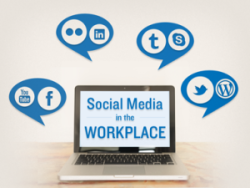“You are what you share.” C.W. Leadbeater
Social Media is not just a part of the social world anymore, but now a part of the business world in which we operate daily as professionals. Companies use social media to communicate updates to their consumers, recruiters use it to assess online behavior, and research is driven from social media engagement data to create new products. These are just a few ways that social media networks are completely changing the landscape of the business world.
As professionals, it is important to to creating a clear social media presence that represents your own personal brand positively. The ability to creating a clear social media presence, communicating ideas, and making connections will be a driving factor in the success of all business people in the virtually connected future.
The Big Three Networks
Whether you are new to social media or an expert, there are three networks all professionals need to be aware of when developing a social media presence. These three are LinkedIn, Facebook, and Twitter. Understanding and utilizing the networks are in every professional’s best interest.
LinkedIn: This is a professionally oriented social media devoted to networking. It is recommended that all professionals have a presence on this network. This allows you to make connections with people you have worked with before, classmates, and people you would like to learn more about. You can update your work information on your profile in a resume type format, allowing recruiters on the network to find you when they search for specific skills. The network also allows you to write articles pertaining to your areas of expertise, directly message your connections, and allows for endorsements and recommendations between your connections.
Many professionals sometimes think that having an active profile means you’re looking for a new opportunity. Nothing can be further from the truth.
There are several ways in which you can make a LinkedIn profile that doesn’t look like you are interested in leaving your company. First, consider putting your job title and company as your heading. For example, “Software Engineer at IBM” could be your heading. This type of heading doesn’t scream you are looking to leave your company. Second, when you are updating your profile, consider going into your profile settings and turn of your notifications. This will not allow your profile to publish any changes you have made to others in your network.
Facebook: This is a personal social media network, as opposed to the more professional LinkedIn network. Members of the network are connected with their close friends, family, and coworkers. The site allows you to share photos, articles, and status updates about your life. Developing a clear presence can be much more difficult on this site because of the gray area between your personal and professional life. Items that you would feel comfortable sharing on this site with close family and friends may not feel appropriate to share with your coworkers. Even if you mitigate this situation by not adding any connections from your professional life, your content can still be shared or copied for the whole world to see. When posting on this site, use the LinkedIn rule to decide if your content is appropriate. If you would feel comfortable explaining said content to your connections on LinkedIn, then you are probably okay posting that material. This doesn’t mean you can’t share a funny photo of your pet or child, it just means that you shouldn’t share any content that would devalue your professional presence.
Several professionals become concerned with whom they should add on their Facebook network. Since this network is more personal, make sure you only add other professional’s that you know on a more personal level. If you have had a personal conversation with this person or have socialized with them in a personal setting, such as grabbing a drink on the weekend, it is probably okay to add this person as a friend. If you are unsure, a good rule of thumb is to wait until said person adds you as a friend first.
Set You Privacy Settings to Private
You can manually develop your privacy setting on Facebook to fit you social media goals. Under the privacy tab in setting, you can choose who can search for your profile, and what people can see when they look at your profile. When you post content to your network, you can also manage the privacy by clicking the arrow in the upper right hand corner.
Twitter: This is also a personal social media network. As a micro-blogging site, you can post up to 140 characters in a tweet to people following you. Unlike Facebook and LinkedIn, when you follow others they don’t automatically follow you back. The same is true when someone follows you, you don’t automatically follow them back either. Twitter allows you to make your account either private or public. A private account means that you have to approve your followers before they can see your profile. A public account means that anyone can follow you and also retweet your content. Several professionals tweet content from their blogs to their public twitter accounts so that it can be retweeted and shared with hundred of other users on the network. Whether you choose to keep your account public or private, remember that anyone could copy your content and share it with others- so make sure to continue to use the LinkedIn rule discussed above.
Set Up a Twitter Account and Follow Your Company
Use hashtags when posting information to gain access to more Twitter users. Using popular hashtags will allow your tweets to populate when other users search for said hashtags. For example, if you tweet about the stock market and use the hashtag #wallstreet, when others search for the hashtag #wallstreet they will see your content. This is a great way to reach people in the Twitter network who can help develop your professional life.
Content provided by Careerminds, Inc.


